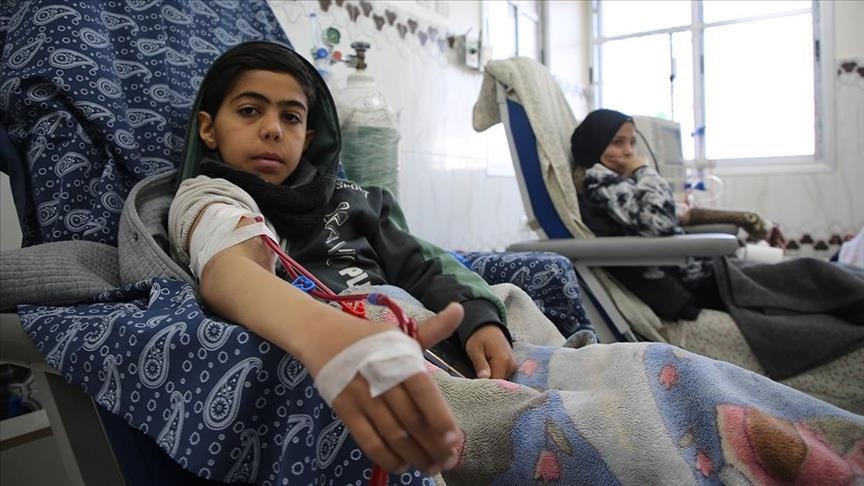
Inside Al-Rantisi Children’s Hospital in Gaza City.
A Look Inside Gaza’s
Last Functioning Children’s Hospital
Abdel Qader Sabbah / Drop Site News
GAZA CITY (September 2, 2025) — Umm Issa Abu Daf sat on the floor of Al-Rantisi Children’s Hospital in Gaza City holding her feverish infant son, Adham. All around her, mothers sat on chairs or on thin mattresses in the hallways, trying to tend to their sick children, many of whom were visibly malnourished or suffering from skin conditions covering their faces and bodies.
“The circumstances are difficult, but I have no choice. There’s nowhere else but this hospital to get him his treatment,” Umm Issa told Drop Site. Al-Rantisi is the only pediatric hospital in Gaza still functioning as other medical facilities have come under attack by the Israeli military and forced to shut down. Yet children and babies are unable to get proper treatment at Al-Rantisi due to massive overcrowding, severe shortages of medical supplies, and a widening famine as a result of the Israeli blockade.
 |
“We’re also worried about the germs and microbes here as kids are very sensitive. They easily get fevers and get sick. But all praise be to God, what else can we do? I’m supposed to be on a hospital bed, and my child should be in a safe, clean place, getting proper treatment. But here I am, on the floor, with no place to sit,” Umm Issa said. “The children are deprived of everything. No diapers, no formula, no proper treatment. Even food, if I want to feed them anything, there’s nothing. I can barely manage.”
Children are particularly vulnerable to Israel’s starvation campaign in Gaza, which reached a tipping point this summer with Palestinians dying of hunger every day. A total of 361 Palestinians have died of hunger since the start of the war, 130 of them children, according to Gaza’s health ministry. At least 185 of those starvation deaths have come in August alone. Some 43,000 children under five are now suffering from malnutrition, according to the health ministry, as Israel has severely restricted the amount of food and aid allowed into the enclave.
“This is the only hospital still providing pediatric medical care, after several other hospitals—like Al-Durra Hospital, Al-Nasr Hospital, Kamal Adwan Hospital, the Indonesian Hospital, and Beit Hanoun Hospital—have all been put out of service,” Dr. Mohammad Madi, the head of the Pediatrics Department at Al-Rantisi, told Drop Site. “Now only Rantisi Children’s Hospital remains. It is the only hospital providing medical care for children.”

“This has caused a massive overflow and overcrowding of children in our hospital and its departments. The bed capacity in the unit I’m working in at Rantisi Hospital is 30 beds. Unfortunately, we currently have 90 cases in this unit. This means we are operating at 300% capacity, which greatly reduces the quality of care that each child can receive because of the congestion. We know that overcrowding leads to the spread of diseases—so imagine what it means for sick children and the level of overcrowding we have here,” he added.
Like other hospitals still functioning in Gaza, Al-Rantisi is suffering from a shortage of supplies and medicine.
“For example, in dermatological conditions, we have no ointments or specific medications available at all. It’s very difficult for us,” Dr. Madi said. “A lot of medications are needed for chronic diseases as well. Chronic diseases such as kidney diseases or those needing biological treatments—like the drug MabThera [used to treat certain autoimmune diseases]—are not available to us. We’re forced to use alternatives, and these alternatives simply don’t suffice.”
The overcrowding has also led to “severe exhaustion and fatigue” among the medical staff, Dr. Madi said. Nurses, who should be overseeing 6 to 10 patients, find themselves responsible for 25 children in a single ward. “This results in physical exhaustion and psychological stress for the healthcare workers here in Gaza City,” Dr. Madi added. “The medical teams are exhausted. The children are not receiving the level of care they need.”
“My child should be in a safe, clean place,
getting proper treatment. But here I am,
on the floor, with no place to sit.”
The lack of available medical staff is plainly visible inside Al-Rantisi. Inside one overcrowded room, Doaa Al-Ladawi held her five-month-old son in her arms as her older daughter worked to attach a nebulizer to an oxygen tank herself.
Doaa Al-Ladawi holds her five-month-old son as her older daughter attaches a nebulizer to an oxygen tank in Al-Rantisi Children’s Hospital in Gaza City on August 26, 2025. (Screenshot of video by Abdel Qader Sabbah.)
“For the medical staff present, it’s only natural that they can’t handle this number of patients. From experience, we’ve learned how to handle some of the basics ourselves, because we always find ourselves coming back to this hospital with our children. And, of course, may God give the medical staff strength,” Al-Ladawi told Drop Site.
“Here’s a simple example: the nebulizer. Each child should have their own device, since these are contagious viral diseases. But at the hospital, they use the same nebulizer for multiple children. An entire department might only have three nebulizer devices. This increases the spread of disease. There’s no medical equipment, no medicine, and diseases are spreading rapidly.”
Humanitarian organizations have warned of a growing epidemic of highly contagious skin infections in Gaza as a result of lack of clean water, poor sanitation and medical care, with children being the worst affected by bacteria, viruses, fungi, and parasites, including outbreaks of scabies, lice, and Bullous Impetigo.
Drop Site News is reader-supported. Consider becoming a free or paid subscriber.